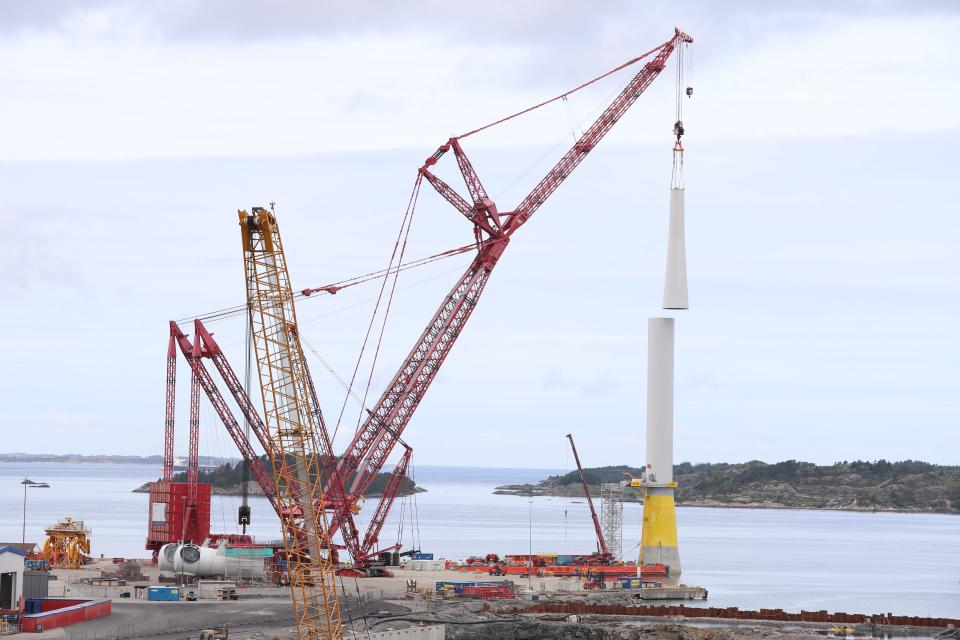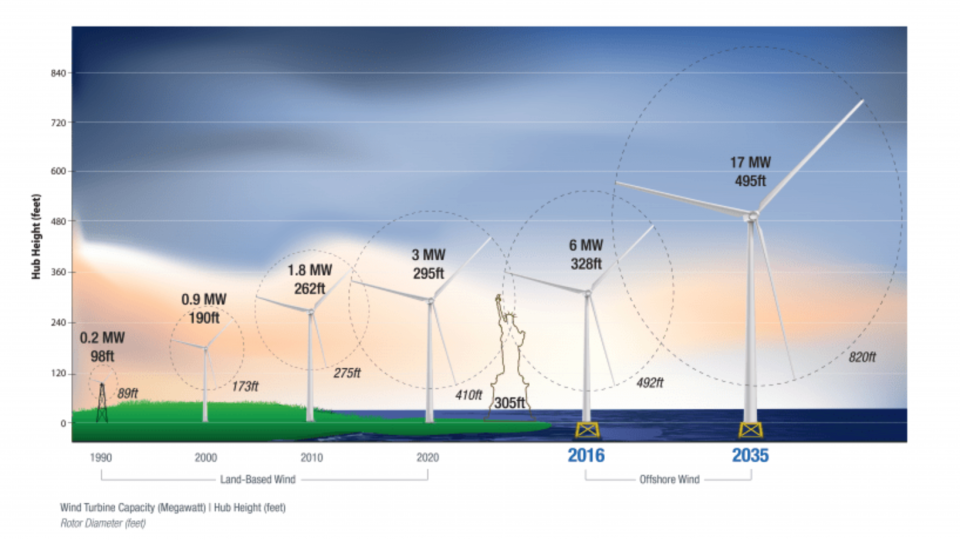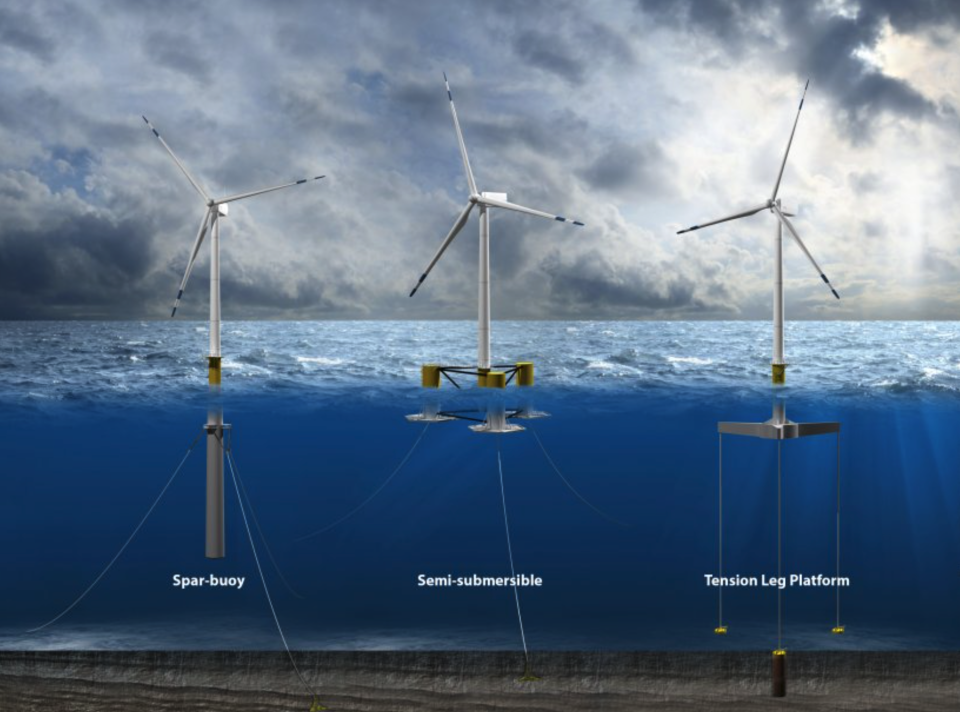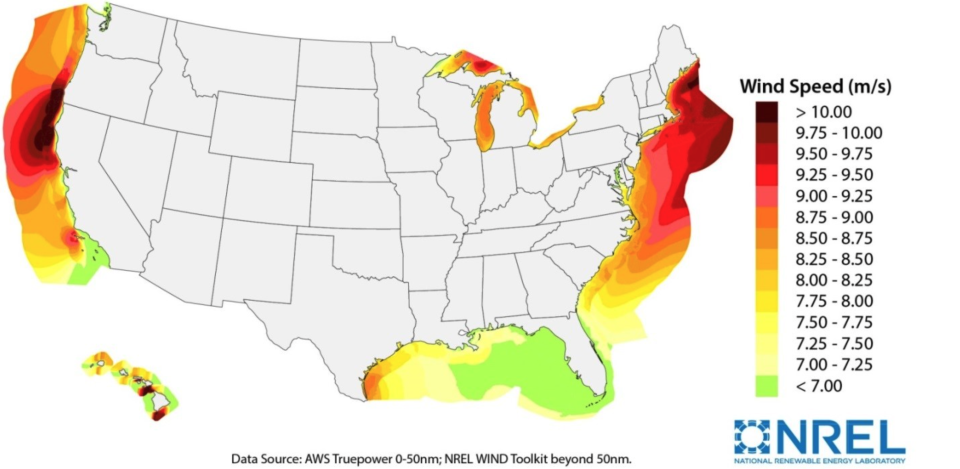Massive wind turbines are coming to a coast near you. Will Biden's 'audacious' goal pay off?
The Biden administration is making a big bet that 60-story wind turbines floating 20 miles or more off the nation’s coasts will produce a significant amount of cheap energy while creating new and lucrative industries.
The initiative, announced last week, invests nearly $50 million to boost floating offshore wind turbine technology, an arena the U.S. has lagged in. It could propel the country to the forefront of cutting edge climate technology.
“What we’re doing is positioning ourselves to lead the world in floating offshore wind,” said White House National Climate Advisor Gina McCarthy.
The announcement included:
A goal of deploying 15 gigawatts of floating offshore wind by 2035, enough to power 5 million homes.
Reducing the cost of electricity from floating wind turbines by 70%, to just 4.5 cents per kilowatt by 2035, less than the cost of electricity from fossil fuels.
A $6.8 million prize competition for floating offshore wind platform technologies.
The administration aims to make floating offshore wind a significant part of the nation's mix, "winning the global race to lead in this space,″ said Energy Secretary Jennifer Granholm. ”That’s why we set this big, hairy, audacious goal.″
It might seem a risky proposition, considering the U.S. has no large-scale floating turbines, and only three utility-scale systems currently operate in the world. But other nations are sprinting ahead with the technology, widely believed to become a critical part of the global renewable energy mix.
While land-based wind turbines are well established in the U.S., the country has fallen "way behind" when it comes to offshore turbines placed in water so deep they cannot be fixed to the ocean floor and must float, said Erin Baker, a professor of industrial engineering at the University of Massachusetts-Amherst's Wind Energy Center.
It's not too late to catch up, she said.
"Floating turbine technology is still emerging," Baker said. "We absolutely can still become leaders."
Secretary-general of the U.N.: 5 steps to help us kick our fossil fuel addiction and save the planet
Logistics remain
The administration's investment reflects the many technical challenges offshore wind faces to be cost-effective, most notably the "floating" part of floating offshore wind.
Engineers know how to build powerful and efficient wind turbines on land and in shallow waters. Hundreds of thousands have been churning out kilowatts of electricity for years.
But the power of wind on the open ocean is immense. Putting turbines the size of skyscrapers on floating platforms more than 200 feet above the sea floor is increasingly seen as the future for the world's power needs.
"Over 80% of the wind resources globally are in deep water," said John Olav Giæver Tande, chief scientist at SINTEF, a Norwegian research institute known for its work on wind energy.
Wind energy had a 'banner year' in 2020: What that means for Biden's climate plan
The United States, with thousands of miles of coastline and world-class offshore wind, is especially well positioned to capitalize on this energy resource.
"Offshore wind is really important because we have an amazing energy resource and it’s near our population centers," said Baker. "One-third of the U.S. population is in a county that includes a coastline."

How floating offshore wind works
Each massive turbine sits on a floating platform. Unlike fixed-bottom turbines, which have foundations that go deep into the ocean floor, deep water turbines float and are fixed to the ocean floor with mooring lines like a ship's anchor. Undersea electrical lines run from the turbines to shore to bring power to where it's needed.
Open ocean turbines can be much larger than land-based ones. The hub of the blades on land is typically about 308 feet, as tall as the Statue of Liberty. In deep water, it's anticipated the hub could be as tall as 500 feet, the height of the Washington Monument.

"The tip of a blade might go up 820 feet above the water – that's really tall." said Walt Musial, who leads the offshore wind team at the National Renewable Energy Laboratory in Golden, Colorado.
Those huge blades, up to 360 feet long, produce a lot of electricity. A single turbine can churn out 15 megawatts of energy, enough to power 5,000 homes, Musial said.
The energy industry expects floating wind technology to soon become cost competitive. Electricity from all wind turbines was 70% cheaper in 2021 than it was in 2009, according to Lazard, a financial advisory firm that publishes annual estimates on energy production costs.
FACT CHECK: Energy costs of wind turbine manufacturing recouped in months
Experts told the Department of Energy last year they expected costs to fall by as much as another 35% by 2035, and almost 50% by 2050.
Other nations are jumping on the floating turbine band wagon. The United Kingdom, Korea and China all have big projects underway, with many more in the pipeline. Last year China installed 17 gigawatts of new offshore wind power, 80% of the global total, according to the Global Wind Energy Council.
In Europe, billions of dollars are expected to be invested in offshore wind over the next 20 to 30 years. "We're talking about something like 300 to 400 gigawatts of offshore power, which will supply one-third of the electricity demand in Europe in 2050," Tande said.

Coming soon to America's shores: What projects are in the works?
The first floating offshore wind turbine prototypes began operating in 2009, a small demonstration turbine off the coast of southern Italy and a large-scale 2.3 megawatt one, known as Hywind, off the Norwegian coast, said Tande.
"There was a lot of skepticism. Would it function? Would it tip over?" he said. "Would the metal be fatigued in such an extreme environment?"
In fact, the open ocean proved a good environment for harvesting wind, and that first turbine was one of the best performing in the world, he said.
The first U.S. floating wind installation, a test site, is planned in the Gulf of Maine. The 11-megawatt demonstration project is scheduled to start operating in 2024.
Three other projects are proposed off the California and Oregon coasts. Auctions for the California leases are anticipated by the end of the year. They would be placed in carefully chosen "wind energy areas," Musial said.
LAST YEAR: Biden administration, Newsom open California coast to offshore wind farms

"Marine sanctuaries are off limits, as are shipping lanes and military use areas," he said. "We're trying to keep them to areas far from shore so they're not going to cause a visual impact on coastal communities."
While all technology has some impact on the environment, it's possible to minimize it with offshore floating wind, said Tande.
"You can do all the assembly work close to harbor and then use tugboats to take the turbines out to the site. That allows offshore installation work to be done fairly quickly without significant noise," he said. "You don't need to drill down into the sea bed."
A good pairing with solar
Placing turbines far out to sea have multiple advantages, experts say.
The environment is windy. The National Renewable Energy Laboratory estimates U.S. offshore wind has the potential to generate up to 2,000 gigawatts of electricity, nearly double the country's current use.
Ocean winds also blow more consistently and tend to peak in the evening, just as solar power arrays on land shut down.
"There's an advantage to having these mixed together," said Musial. "The wind comes up as solar goes down."
Offshore wind also will generate manufacturing and construction jobs. That's partly because the components are so large it doesn't make sense to source them from overseas suppliers like China, he said.
Shallow-water wind turbines already are generating industries and manufacturing that will support turbines further out, said Musial.
A factory in New Jersey is being constructed to build the foundations for offshore wind turbines and is scheduled to come online in 2025, he said.
MORE: 6 companies bid record $4.37B for offshore leases in New York, New Jersey
"There were zero companies making high voltage subsea cables before," he said. "Now there are at least two in the United States, one in North Carolina and one in Massachusetts," he said.
Experts acknowledge floating wind turbines still face hurdles. But they say efforts must begin now to scale up the technology as a climate and energy crisis looms.
"The only thing we can do wrong right now is to do too little to develop it," he said.
Elizabeth Weise covers climate change and the energy transition. Contact her at eweise@usatoday.com
Contributing: Associated Press
This article originally appeared on USA TODAY: Is Biden's offshore wind turbine plan worth it? What to know.

